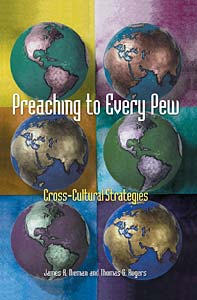Preaching to Every Pew, reviewed by Aldwin Ragoonath
 James R Nieman and Thomas G Rogers, Preaching to Every Pew: Cross-Cultural Strategies (Minneapolis: Fortress Press, 2001), 159 pages, ISBN 9780800632434.
James R Nieman and Thomas G Rogers, Preaching to Every Pew: Cross-Cultural Strategies (Minneapolis: Fortress Press, 2001), 159 pages, ISBN 9780800632434.
This book is a “must-read” for every city church pastor because most city congregations have become multicultural. I have found in my own study that the majority of Pentecostal churches are racially, ethnically and socially mixed (“Pentecostal Preaching in North America” Th.D. dissertation, 2000).
Both of the book’s authors are Lutheran ministers, members of the Academy of Homiletics and are practicing homileticians. Nieman’s interest is in combining homiletical research with social sciences. Rogers’ is interested in preaching and cross-cultural communication (his PhD is in homiletics).
This book is the result of extensive research and study about how pastors preach to a congregation of people that represents different cultures, languages, ethnicity, races and social classes. The authors build upon the experiences of pastors, analyze their situations and make recommendations.
In a world where the accepted norm is “me,” “myself” and “I”, with the added professionalism of the clergy, this book is a fresh and helpful work.
In the first chapter the authors present a biblical basis for multicultural communication and preaching. Jesus serves as the best example of cross-cultural communication. (One example is when He spoke and ministered to the Samaritan woman drawing water from the well). In chapters two to five the authors outline the main points of cross-cultural strategies. They are the frame of ethnicity, the frame of class, the frame of displacement and the frame of beliefs.
The frame of ethnicity, culture and race are the same. The frame of class refers to social status. The frame of displacement is about people who have moved from one place to another and who feel unattached to their present location. The frame of beliefs deals with people who have various views of Christianity. The background of a person influences their view of Christianity. For example, people who become Christians after being in a Buddhist background will have a different view of Christianity than someone who comes from rural America. (Christianity is a synthesis of former and present cultures).
At the end of each chapter Nieman and Rogers present suggestions on how to preach in various situations and then, in their final chapter, re-affirm the importance of being a loving and caring neighbor.
The authors suggest the best way to minister effectively to a cross-cultural congregation is to genuinely love the people, to treat people as neighbors in the biblical sense of the word. Pastors should treat people as part of the body of Christ. Even though there are differences each person is equally important. Pastoral preaching should be inclusive of each represented culture by adding illustrations and symbols in their sermons that will apply to the various groups in the congregation. (Or it could be a picture on the wall of one or more of the cultures represented). The preaching style should be flexible so as to meet the needs of the audience—it can be monologue, dialogue or a mixture of these two. The preaching should be Christocentric and must give hope. Augustine is a good example of someone who spoke effectively to a mixed audience.


